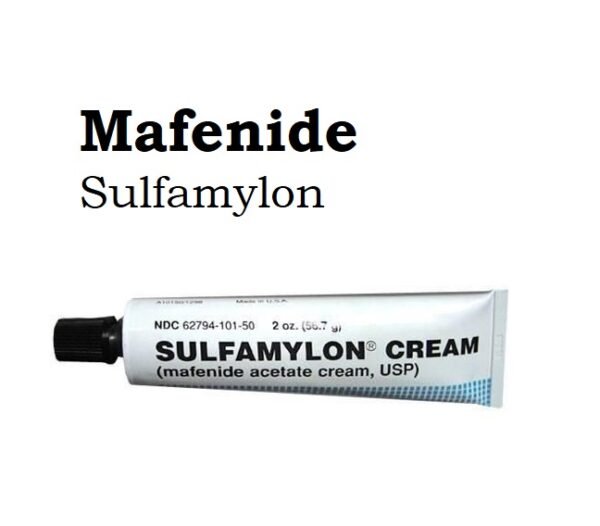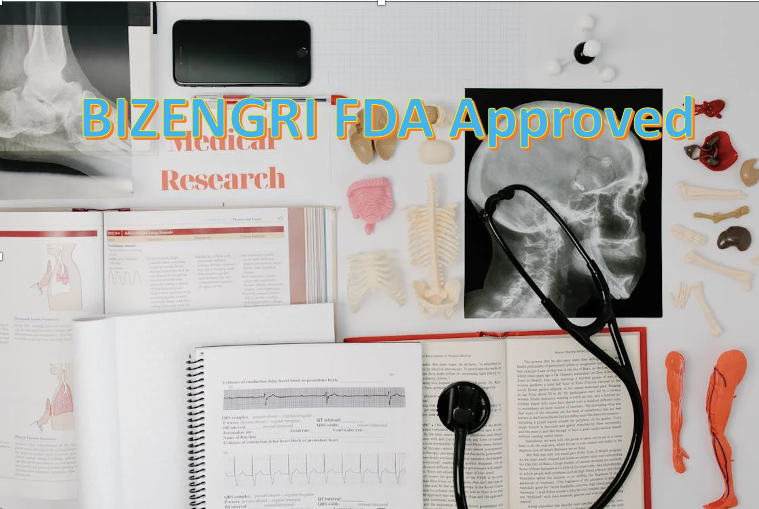Mafenide is an antimicrobial medication used primarily to prevent or treat infections in burn wounds. It belongs to the class of sulfonamide antibiotics. Mafenide works by inhibiting the growth of bacteria on the skin, which helps to prevent infections from developing in the burned areas. It's typically applied topically as a cream or solution directly to the burned area.
A broad-spectrum antibiotic with efficacy against both gram-positive and gram-negative bacteria, including Pseudomonas aeruginosa, is mafenide (Sulfamylon). It is used as a topical solution or cream in patients with second or third-degree burns.
Mafenide (Sulfamylon) Uses:
- Burn treatment:
- It is used as an adjunctive treatment in patients with second-degree or third-degree burns as a topical antimicrobial cream to control bacterial infection.
- Under moist dressings, it is applied over mesh autografts on excised burn sites.
Mafenide (Sulfamylon) Dose in Adult:
Mafenide (Sulfamylon) Dose in the treatment of Burn: Topical:
- Cream:
- Use once or twice daily with clean hands.
- Put a thin layer on the burned area; you don't need to apply it too thickly.
- Keep the burned area covered with cream all the time.
- Keep using it until the burn is healing well or until it's ready for grafting.
- Powder for solution:
- Soak an 8-ply dressing with the solution and cover the area where the skin graft will be placed.
- Make sure the dressing stays wet by using a syringe or irrigation tubing every 4 hours, or as needed.
- Alternatively, you can moisten the dressing every 6 to 8 hours, or as needed.
- Keep doing this until the graft site has good blood flow and is healing well.
- You can leave the dressings on for up to 5 days.
Mafenide (Sulfamylon) Dose in the treatment of Burns: Topical:
In infants, children, and adolescents:
- Cream: Apply once or twice daily using clean, gloved hands. Put on a thin layer of cream, covering the burned area completely. Keep the area covered with cream at all times.
For infants aged 3 months and older, children, and adolescents:
- Solution (5%): Cover the graft area with a layer of fine mesh gauze. Then, soak an 8-ply burn dressing with mafenide solution and cover the graft area. Keep the dressing wet by using a syringe or irrigation tubing every 4 hours, or as needed. Alternatively, you can moisten the dressing every 6 to 8 hours, or as needed. Secure the irrigation dressing with bolster dressing and wrap it appropriately. You can leave the dressings on for up to 5 days.
Pregnancy Risk Category: C
- In studies with animals, no harmful effects were seen when the medicine was taken by mouth during pregnancy.
- However, the makers of the cream advise against using it in women who could become pregnant unless the burn covers more than 20% of the body or if the benefits of using the cream are greater than any risks to the baby.
Use Mafenide while breastfeeding
- It's uncertain whether mafenide passes into breast milk.
- Because there's a risk of severe side effects in nursing infants, a decision should be made whether to stop breastfeeding or to stop taking the medication, considering how important the treatment is for the mother.
Mafenide (Sulfamylon) Dose in Kidney Disease:
- The manufacturer's instructions do not include specific dosage adjustments for people with kidney problems.
- It's important to be cautious because there might be an accumulation of both the original drug and its byproducts in the body, which could increase the inhibition of carbonic anhydrase.
Mafenide (Sulfamylon) Dose in Liver disease:
- The manufacturer's instructions do not mention any dosage adjustments for individuals with liver problems.
Side effects of Mafenide (Sulfamylon):
- Cardiovascular:
- Edema
- Facial Edema
- Dermatologic:
- Erythema
- Maceration
- Pruritus
- Rash
- Urticaria
- Endocrine & Metabolic:
- Hyperchloremia
- Metabolic Acidosis
- Gastrointestinal:
- Diarrhea (Following Accidental Ingestion)
- Hematologic:
- Bleeding
- Bone Marrow Suppression
- DIC
- Eosinophilia
- Hemolytic Anemia
- Porphyria
- Local:
- Blisters
- Burning Sensation,
- Excoriation
- Pain
- Respiratory:
- Dyspnea
- Hyperventilation
- Pco Decreased
- Tachypnea
- Miscellaneous:
- Hypersensitivity
Contraindications to Mafenide (Sulfamylon):
- If someone has a hypersensitivity (allergic reaction) to mafenide or any ingredient in the formulation, they should not use it.
Warnings and precautions
Acid-base imbalance
- Mafenide and its metabolite can affect the balance of acids and bases in the body by inhibiting carbonic anhydrase, leading to a condition called metabolic acidosis.
- Symptoms may include increased breathing to compensate (hyperventilation).
- People with kidney problems are at higher risk.
- In some cases, patients may not show obvious signs of hyperventilation and may develop respiratory alkalosis, though it's not clear why this happens.
- It's important to monitor the balance of acids and bases, especially in patients with large second-degree burns or burns that affect multiple layers of skin, as well as those with lung or kidney issues.
Allergy to sulfonamide
- People with a known allergy to sulfonamide drugs should not use mafenide.
- This is because sulfonamide antibiotics, like mafenide, share similarities with other medications like sulfonylureas, carbonic anhydrase inhibitors, thiazide diuretics, and loop diuretics (except ethacrynic acid).
- While mafenide's labeling specifically prohibits its use in individuals with a sulfonamide allergy, there's still a risk of reacting to mafenide if someone has had a severe allergic reaction to any of these related compounds.
- In such cases, it's best to avoid using mafenide.
Superinfection
- Using mafenide for a long time can lead to superinfections caused by bacteria or fungi.
- This includes conditions like Clostridium difficile-associated diarrhea (CDAD) and pseudomembranous colitis.
- It's important to note that CDAD has been seen to occur more than two months after finishing antibiotic treatment.
G6PD deficiency:
- Patients with glucose-6-phosphate dehydrogenase (G6PD) deficiency should be cautious when using mafenide.
- There have been reports of hemolytic anemia with disseminated intravascular coagulation (DIC), including cases where the outcome was fatal, associated with mafenide use, particularly in individuals with G6PD deficiency.
Renal impairment
- Mafenide should be used cautiously in burn patients with acute renal impairment.
- This is because there may be an accumulation of both the original drug and its byproducts in the body, which could increase the inhibition of carbonic anhydrase and raise the risk of metabolic acidosis.
Mafenide: Drug Interaction
|
BCG Vaccine (Immunization) |
Antibiotics may reduce the BCG vaccine's therapeutic effect (Immunization). |
|
Dapsone (Topical) |
May enhance the adverse/toxic effect of Methemoglobinemia Associated Agents. |
|
Local Anesthetics |
Methemoglobinemia Associated Agents may enhance the adverse/toxic effect of Local Anesthetics. Specifically, the risk for methemoglobinemia may be increased. |
|
Nitric Oxide |
May intensify the harmful/toxic effects of agents associated with methemoglobinemia. Combinations of these medications may make substantial methemoglobinemia more likely. |
|
Prilocaine |
The harmful or toxic effects of Prilocaine may be increased by methemoglobinemia associated agents. Combinations of these medications may make substantial methemoglobinemia more likely. Management: When prilocaine is combined with other medications known to cause the development of methemoglobinemia, patients should be watched for symptoms (such as hypoxia and cyanosis). When giving these medicines to newborns, avoid using lidocaine or prilocaine. |
|
Sodium Nitrite |
The harmful or toxic effects of sodium nitrite may be amplified by methemoglobinemia-associated agents. Combinations of these medications may make substantial methemoglobinemia more likely. |
|
Sodium Picosulfate |
Antibiotics may reduce Sodium Picosulfate's therapeutic impact. Management: If a patient previously used or is currently using an antibiotic, think about utilising an alternative product for bowel cleansing prior to a colonoscopy. |
|
BCG (Intravesical) |
Antibiotics may lessen BCG's therapeutic effects (Intravesical). |
Monitoring parameters:
Acid-Base Balance:
- Mafenide can affect the balance of acids and bases in the body.
- It may cause metabolic acidosis, which can lead to symptoms like increased breathing (hyperventilation).
- People with kidney problems are at higher risk of experiencing this imbalance.
- Some patients may not show obvious signs of hyperventilation and may develop respiratory alkalosis, but it's not clear why this happens.
- It's important to monitor the balance of acids and bases, especially in patients with large burns or lung/kidney issues.
Signs of Infection:
- Prolonged use of mafenide may lead to fungal or bacterial infections.
- This can include conditions like Clostridium difficile-associated diarrhea (CDAD) and pseudomembranous colitis.
- CDAD can occur even after stopping antibiotic treatment, sometimes more than two months later.
- Look out for symptoms like persistent diarrhea, abdominal pain, and fever.
Signs of Healing:
- Watch for signs that the burn wounds are getting better.
- Look for reduced redness, swelling, and pain in the burned area.
- New skin growth or scabbing over the burn site are positive signs.
- Healing may also involve a decrease in the amount of fluid draining from the wound.
How to administer Topical Mafenide (Sulfamylon)?
Topical Application:
Cream:
- For external use only.
- Keep the burn area covered with cream at all times.
- Dressings are usually not needed, but if necessary, use only a thin layer.
- Apply the cream to a clean, debrided area using a sterile gloved hand.
- Apply it thinly, about the thickness of a dime.
- Don't stop using the cream even if there's a chance of infection.
- If possible, the patient should bathe daily to help remove dead tissue (debridement). This can be done with a whirlpool bath, shower, or bed bath.
Powder for Solution:
- For external use only.
- Cover the graft area with one layer of fine mesh gauze.
- Soak an 8-ply burn dressing with the solution until it starts to leak, then cover the graft area.
- Keep the dressing wet by using a syringe or irrigation tubing, or by moistening the dressing.
- Place the irrigation tubing over the burn dressing so it touches the wound, and use another 8-ply dressing to cover it.
- Secure the irrigation dressing with a bolster dressing and wrap it as needed.
Mechanism of action of Mafenide (Sulfamylon):
- As a sulfonamide, mafenide works by disrupting the production of folic acid in bacteria.
- It does this by competing with para-aminobenzoic acid, which is needed for folic acid synthesis.
- Its effectiveness extends to a wide range of bacteria, including both gram-positive and gram-negative types.
- This includes organisms like Pseudomonas and certain anaerobic bacteria.
Absorption:
- Mafenide easily passes through areas of damaged tissue without a blood supply and gets quickly absorbed from burned skin surfaces.
Metabolism:
- It transforms into a compound called para-carboxybenzene sulfonamide.
- Both mafenide and its metabolite work as carbonic anhydrase inhibitors.
Time to Peak:
- Cream 11%: It reaches its highest level in the blood after 2 to 4 hours.
- Cream 11% in Burn Tissue: It peaks at around 2 hours.
- Solution 5% in Burn Tissue: It peaks at around 4 hours.
Excretion:
- It's eliminated from the body primarily through urine, mainly as metabolites.
International Brands of Mafenide:
- Sulfamylon
- Homonal
- Mafatate
- Mefede
- Sulfamylon
- Sulfomyl
Mafenide Brands Names in Pakistan:
No Brands Available in Pakistan.




